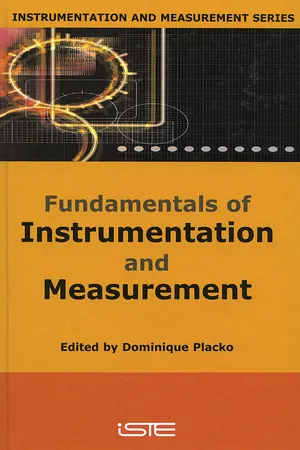Physics
Sensors
Sensors are devices that detect and measure physical properties such as temperature, pressure, light, and motion. They convert these measurements into electrical signals that can be processed and analyzed. In physics, sensors play a crucial role in collecting data for experiments, monitoring environmental conditions, and controlling various systems.
Written by Perlego with AI-assistance
Related key terms
2 Key excerpts on "Sensors"
- eBook - ePub
- Dominique Placko(Author)
- 2013(Publication Date)
- Wiley-ISTE(Publisher)
Chapter 3 1Physical Principles of Optical, Thermal and Mechanical Sensors
There are now so many Sensors available [NOR 89] that it would be impossible to discuss the principles of all of them in a single chapter. We have therefore limited ourselves to three classes of measurands: optical, thermal and mechanical. However, even with this restriction, we still must limit our scope, and will only present the most frequently used laws for these types of physical Sensors.3.1. Optical Sensors
One important class of Sensors detects electromagnetic beams. Within this group, we will restrict our discussion to those optic Sensors that are sensitive only to beams with wavelengths of 10 nm − 1 mm, that is, frequencies of between 1016 and 1011 Hz.In the specific case of light Sensors, for reasons relating to the sensitivity of the human eye, it is necessary to introduce specific concepts when discussing visibility (0.4 μm to 0.8 μm). After a brief recapitulation of the variables that act as measurands for optical Sensors, we will define the reference light source used in making calibrations. We will then discuss the principles of Sensors that are used in constructing semiconductors.3.1.1. Energetic flux
An electromagnetic beam transmits energy. One way to see this is to place a thermometer with a darkened reservoir in an electromagnetic beam and check that the temperature increases. We know that the flux of Poynting’s vector, the vectorial product of electrical and magnetic fields, across a surface S surrounding a closed volume V, is equal to the quantity of electromagnetic energy W that comes from V by the surface S and by unity of time. This flux can be expressed by means of the divergence of and the local electromagnetic energy density, as we see in Figure 3.1 - eBook - ePub
Electronic Portable Instruments
Design and Applications
- Halit Eren(Author)
- 2003(Publication Date)
- CRC Press(Publisher)
In microwave and Doppler radars, the Sensors contain Gunn diode oscillators (about 10-mW output) located in launching horns, and the receiving horns contain mixer diodes. The microwave beam, typically 10.7 GHz, is generated by the Gunn diode, and a low-frequency signal is generated when any object in the field of view moves. This signal is extracted suitably to work as a proximity detector of the moving object.2.16.2 Pressure Sensors
Pressure is defined as the normal force exerted on the unit surface area of an object. The SI unit of pressure is the Pascal (Pa), after Blaise Pascal (1623–1662), which is defined as newtons per square meter (Nm− 2 ). There are three types of pressure measurements that can be performed:- Absolute pressure—the pressure difference between the point of measurement and perfect vacuum where pressure is zero
- Gauge pressure—the pressure difference between the point of measurements and the ambient pressure
- Differential pressure—the pressure difference between two points
Some pressure Sensors involve large mechanical parts and permanent linkages that make them unsuitable for portable instruments. However, many electronic portable instruments are available, particularly for gas pressure measurements. The type of Sensors suitable for a particular application depends on characteristics of the object under investigation, such as gas, air, or liquid. Also, there are different types of Sensors for low-pressure, high-pressure, and differential pressure measurements.Most pressure Sensors operate on the principle of converting pressure to some form of physical displacement, such as compression of a spring or deformation of an object. If displacement is used, there are many options for converting displacement into electrical signals. However, because of the heavy reliance on the physical displacements, many pressure Sensors are sensitive to vibration and shock, which introduces a drawback to their use in portable instruments.Pressure can be sensed directly or indirectly. Indirect methods rely on the action of pressure to cause displacement of a diaphragm, a piston, or other device, so that the electronic sensing of displacement can be related to the pressure. The most commonly employed method is indirect pressure sensing. However, there are both direct and indirect pressure Sensors for atmospheric pressure sensing (about 101.3 kPa).
Learn about this page
Index pages curate the most relevant extracts from our library of academic textbooks. They’ve been created using an in-house natural language model (NLM), each adding context and meaning to key research topics.

